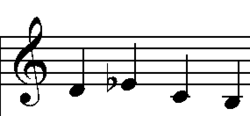- DSCH motif
-
DSCH is a musical motif used by the Russian composer Dmitri Shostakovich to represent himself. It is a musical cryptogram in the manner of the BACH motif, consisting of the notes D, E flat, C, B natural, or in German musical notation D, Es, C, H (pronounced as "De-Es-Ce-Ha"), thus standing for the composer's initials in German transliteration: D. Sch. (Dmitri Schostakowitsch), also pronounced as "De-Es-Ce-Ha."
Contents
Usage
By Shostakovich
The motif occurs in many of his works, including the Symphony No. 10 in E minor, the String Quartet No. 8 in C minor, the Violin Concerto No. 1 in A minor, the Cello Concerto No. 1 in E flat Major, the Symphony No. 15 in A major and the Opus 61 Piano Sonata No. 2 in B minor.
By others
Many homages to Shostakovich (such as Schnittke's Preludy in memory of Dmitri Shostakovich or Tsintsadze's 9th String Quartet) make extensive use of the motif. The British composer Ronald Stevenson composed a large Passacaglia on it. Also Edison Denisov dedicated some works (1969 DSCH for clarinet, trombone, cello and piano, and his 1970 saxophone sonata) to Shostakovich, by quoting the motif several times and using it as the first 4 notes of a twelve-tone series. Denisov was Shostakovich's protégé for a long time.[citation needed]
One of Benjamin Britten's most famous works, Rejoice in the Lamb, contains the DSCH motif repeated several times in the accompaniment, progressively getting louder each time, finally at fortissimo over the chords accompanying "And the watchman strikes me with his staff". The vocal text given to the motive is "silly fellow, silly fellow, is against me".
A further reference appears in Britten's The Rape of Lucretia, where the DSCH motif acts as the main structural component of Lucretia's aria "Give him this orchid."
The contemporary Italian composer Lorenzo Ferrero made use of it in DEsCH, a composition for oboe, bassoon, piano and orchestra written in 2006 to commemorate the 100th anniversary of Shostakovich's birth, and in Op.111 - Bagatella su Beethoven (2009), which blends themes from the Piano Sonata No. 32 in C minor, Op.111 by Ludwig van Beethoven with the Shostakovich musical monogram.
DSCH Journal, the standard journal of Shostakovich studies, takes its name from the motif, and "DSCH" is sometimes used as an abbreviation of the composer's name.
DSCH Publishers is a Moscow publishing house that published the 150-tome New Collected Works of Dmitri Shostakovich in 2005, 25% of which contained previously unpublished works.[1]
Media
See also
- Sacher hexachord
Bibliography
- Brown, Stephen C., “Tracing the Origins of Shostakovich’s Musical Motto,” Intégral 20 (2006): 69–103.
External links
Early ......Common practice Modern and contemporary DSCH motif, Schoenberg hexachordSacher hexachord21st centuryBACH motif, DSCH motif, Sacher hexachord, Schoenberg hexachordOther OtherCategories:- Melodic sections
- Motifs
Wikimedia Foundation. 2010.

